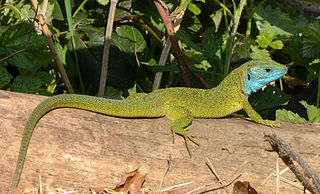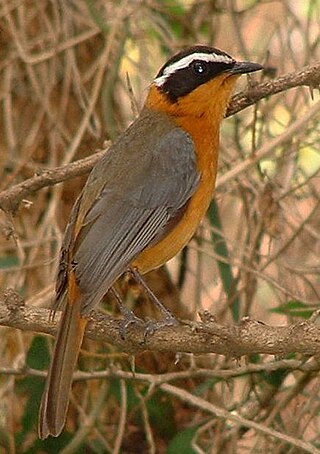
The red-throated wryneck, also known as the rufous-necked wryneck or red-breasted wryneck, is a species of wryneck in the woodpecker family closely related to the Eurasian wryneck. Its three subspecies are resident in much of sub-Saharan Africa in open habitats with some trees. It is a slim, elongated bird about 19 cm (7.5 in) in length, with a small head, fine bill, long fan-shaped tail and cryptic plumage intricately patterned in greys and browns. The sexes look similar, although males are slightly larger. The diet of the adults and young is almost entirely ants at all stages of their life cycles. The call of the red-throated wryneck is a series of repeated harsh, shrill notes. When threatened, a bird will twist its neck and head in a snake-like manner while making a hissing sound, presumably to deter predators.

The African black duck is a species of duck of the genus Anas. It is genetically closest to the mallard group, but shows some peculiarities in its behavior and plumage; it is accordingly placed in the subgenus Melananas pending further research.

The red-billed quelea, also known as the red-billed weaver or red-billed dioch, is a small—approximately 12 cm (4.7 in) long and weighing 15–26 g (0.53–0.92 oz)—migratory, sparrow-like bird of the weaver family, Ploceidae, native to Sub-Saharan Africa.

The European green lizard is a large lizard distributed across European midlatitudes from Slovenia and eastern Austria to as far east as the Black Sea coasts of Ukraine and Turkey. It is often seen sunning on rocks or lawns, or sheltering amongst bushes.

The dwarf crocodile, also known as the African dwarf crocodile, broad-snouted crocodile or bony crocodile, is an African crocodile that is also the smallest extant (living) species of crocodile.

The cardinal woodpecker is a widespread and common resident breeder in much of sub-Saharan Africa. It occurs in a wide range of habitats, ranging from dense forest to thorn bush. It is fairly vocal and is easily identified by its call notes. The sexes are distinguishable by their head patterns.

The black-shanked douc is an endangered species of douc found mostly in the forests of Eastern Cambodia, with some smaller populations in Southern Vietnam. The region they are mostly found in is called the Annamite Range, a mountainous area that passes through Cambodia and Vietnam. Its habitat is mostly characterized by evergreen forest in the mountains, in the middle to upper canopy. They move around quadrupedally and by brachiation up in the trees. This species is unique with its coloration among the doucs as it has a bluish face with yellow rings around its eyes a blue scrotum and a pink penis. Like other doucs, this species has a tail as long as its body and head length. Black-shanked douc have been observed in groups ranging from 3 to 30 individuals, depending on their habitat. Group tend to have a fission-fusion dynamic that changes with food availability. Their diet varies from dry to wet season. Regardless of the season, their diet consists mostly of leaves, but they have also been found to consume considerable amounts of fruits and flowers during wet season. The species changed conservation status in 2015 from endangered to critically endangered in the IUCN Red List of Endangered Species. This reassessment is due to an increase of the rate of population decline. No global population estimate exists. The majority of the population can be found in Cambodia, with smaller populations in Vietnam. In fact, the Wildlife Conservation Society reports almost 25,000 individuals in Cambodia's Keo Seima Wildlife Sanctuary, a population that has remained stable over the last decade. The largest populations estimated to be in Vietnam is around 500-600 individuals. The biggest challenges that the black-shanked douc faces in terms of conservation are habitat loss and illegal poaching. Conservation efforts are being made to control illegal poaching and trade in Vietnam by putting laws against hunting and trading threatened species.

Arthroleptis variabilis is a species of frog in the family Arthroleptidae. It is found in the lowlands of eastern Nigeria, Cameroon, Equatorial Guinea, Gabon, the Central African Republic, the Republic of the Congo, and the Democratic Republic of the Congo. Earlier records west from Nigeria refer to other species, including Arthroleptis krokosua described in 2008. Common names Buea screeching frog and variable squeaker frog have been coined for it.
Leptodactylodon polyacanthus is a species of frog in the family Arthroleptidae. It is found in the highlands of western Cameroon and on the Obudu Plateau in eastern Nigeria. Common name African egg frog has been coined for it.

Sclerophrys camerunensis is a species of toad in the family Bufonidae. It is found in southeastern Nigeria, southern Cameroon, Equatorial Guinea, Gabon, the Central African Republic, and the Democratic Republic of the Congo. The record from southwestern Tanzania is uncertain. It is presumed to occur in the Republic of the Congo. Records from West Africa probably refer to Sclerophrys togoensis. Common names Cameroon toad and Oban toad have been coined for this species.
Leptopelis christyi, also known as the Christy's tree frog or Christy's forest treefrog, is a species of frog in the family Arthroleptidae. It is known with confidence from eastern and northeastern Democratic Republic of Congo, southern and western Uganda, and northwestern Tanzania. It is likely to occur in Burundi and Rwanda, possibly ranging further in East Africa. There is an isolated population in Cameroon and Gabon that might represent a distinct species. The specific name christyi honours Dr. Cuthbert Christy, a British army doctor who collected the holotype.

Petropedetes is a genus of frogs in the family Petropedetidae, found in sub-saharan tropical Africa. In 2002, the genus absorbed all three species of the genus Arthroleptides, but they were moved back in 2014. The informally assigned common name for frogs in this genus is torrent frogs.
Petropedetes newtonii is a species of frog in the family Petropedetidae. It is found in the island of Bioko and in coastal Cameroon. It has been confused with Petropedetes vulpiae and Petropedetes johnstoni, and also considered a synonym of the latter. Because the holotype of Petropedetes newtonii is lost, a neotype was designated in 2018. Common name Newton's water frog has been coined for it.
Petropedetes palmipes is a species of frog in the family Petropedetidae. It is known from a few localities in southwestern Cameroon, Equatorial Guinea, and western Gabon. Common name Efulen water frog has been coined for it.
Petropedetes parkeri is a species of frog in the family Petropedetidae. It is found in western Cameroon and eastern Nigeria. Records from Equatorial Guinea and Gabon are uncertain, possibly belonging to Petropedetes euskircheni. P. parkeri is named after Hampton Wildman Parker, a British zoologist and herpetologist from the Natural History Museum, London. Common names Parker's water frog and Parker's torrent frog have been proposed for it.
Petropedetes perreti is a species of frog in the family Petropedetidae. It is endemic to Cameroon. It is known from the southern slopes of the Bamiléké Plateau, Mount Manengouba, and Mount Nlonako. Common name Perret's water frog has been coined for it.

The freckled nightjar or freckled rock nightjar is a species of nightjar in the family Caprimulgidae. It has a wide yet patchy distribution throughout the Afrotropics.

The white-browed robin-chat, also known as Heuglin's robin, is a species of bird in the family Muscicapidae. Found in east, central and southern Africa, its natural habitats include riverine forest and thickets, and it is also found near humans. The IUCN classifies it as a least-concern species.

Leptopelis aubryioides, the Kala forest treefrog, is a species of frog from the Leptopelis genus of the Arthroleptidae family. It is native to west equatorial Africa, where its range includes southern Cameroon, southern Republic of the Congo (RotC), Gabon, and southeastern Nigeria. It was shown to be abundant in a 2016 population study in these areas, but this is not the full extent of its range. It inhabits both dense lowland old-growth and open secondary forest around inland waters, near where its eggs are laid in ground-level nests. The species occurs at elevations of up to 1,000 m (3,300 ft).
Petropedetes euskircheni is a species of African torrent frog found in Cameroon.














